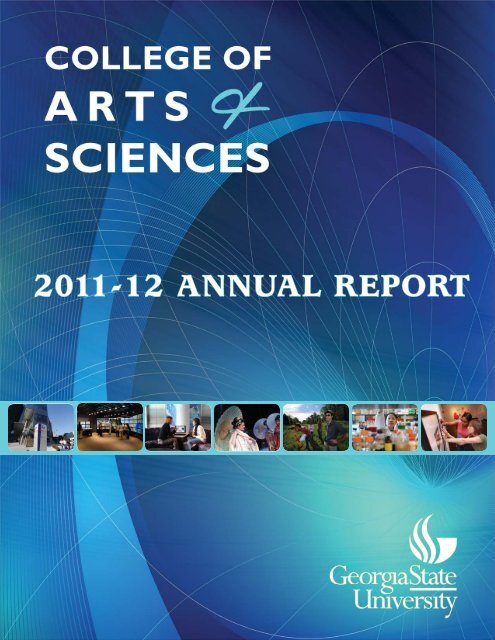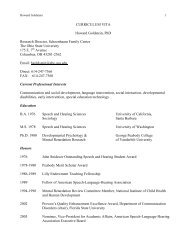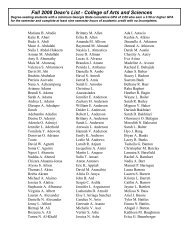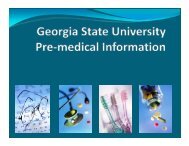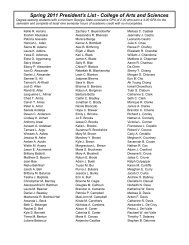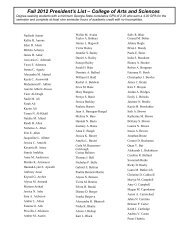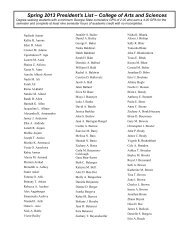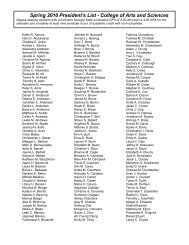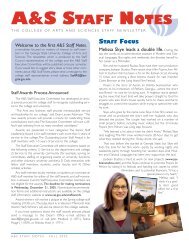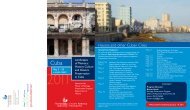2011-12 - College of Arts & Sciences - Georgia State University
2011-12 - College of Arts & Sciences - Georgia State University
2011-12 - College of Arts & Sciences - Georgia State University
You also want an ePaper? Increase the reach of your titles
YUMPU automatically turns print PDFs into web optimized ePapers that Google loves.
<strong>2011</strong>-<strong>12</strong> ANNUAL REPORT
<strong>2011</strong>-<strong>12</strong> Annual Report<strong>College</strong> <strong>of</strong> <strong>Arts</strong> & <strong>Sciences</strong><strong>Georgia</strong> <strong>State</strong> <strong>University</strong>TABLE OFCONTENTSARTS & SCIENCES CONTRIBUTIONS TO THE UNIVERSITY’S STRATEGIC GOALSGoal One ......................................................................................................Become a national model for undergraduate education by demonstrating thatstudents from all backgrounds can achieve academic and career success at highrates.Goal Two .......................................................................................................Signifi cantly strengthen and grow the base <strong>of</strong> distinctive graduate and pr<strong>of</strong>essionalprograms that assure development <strong>of</strong> the next generation <strong>of</strong> researchersand societal leaders.Goal Three ....................................................................................................Become a leading public research university addressing the most challengingissues <strong>of</strong> the 21st century.Goal Four ......................................................................................................Be a leader in understanding the complex challenges <strong>of</strong> cities and developingeffective solutions.Goal Five .......................................................................................................Achieve distinction in globalizing the <strong>University</strong>.24579OTHER ARTS AND SCIENCES ACCOMPLISHMENTS● CENCIA Events .......................................................................................................................................● New International Agreements .....................................................................................................● Global Efforts ............................................................................................................................................● Model Arab League ...............................................................................................................................● Research Funding ....................................................................................................................................● Development..............................................................................................................................................● Outstanding Alumni Award .............................................................................................................● Facilities .........................................................................................................................................................89101011131314
The initiative connects experts from across the country towork toward improvements in curriculum design, course dissemination,and collaborative teaching and learning.Our students are visibly responding to these efforts. <strong>Arts</strong>and <strong>Sciences</strong> retained more fi rst- and second-year studentsthan the university average between fall 2010 and fall <strong>2011</strong>,and the DFW rates (i.e., those students who received a D oran F or who withdrew from a class) dropped by 0.8 percentin the same period.The number <strong>of</strong> students going on to either full employmentor to graduate school also grew by roughly 2 percent in thesame period. And surveys show increased student satisfactionon measures ranging from departmental mentoring tooverall quality <strong>of</strong> instruction in one’s major.Finally, the college worked with university colleagues tomake plans for developing “signature experiences” forundergraduates, as called for in the university’s strategicplan. This new program should provide students with awide range <strong>of</strong> options for enriching their classroom education,including: engaging in high-level research; working andstudying in the communities, corporations, nonpr<strong>of</strong>i ts andgovernment agencies <strong>of</strong> metro Atlanta; and study abroad.<strong>Arts</strong> and <strong>Sciences</strong> students and academic teams continuedto earn honors and awards for their achievements this year.A few examples include:• <strong>Arts</strong> and <strong>Sciences</strong> students took seven awards in threecategories at the <strong>Georgia</strong> <strong>State</strong> Undergraduate ResearchConference (pictured below). Catherine Stankus, a seniorart history major, took the Provost’s award for her presentationon the art <strong>of</strong> eighteenth-century snuffboxes.In addition to college-level efforts to support undergraduates,our faculty is also deeply committed to supportingstudent achievements. Examples include:• <strong>Arts</strong> and <strong>Sciences</strong> faculty taught more than 90 percent<strong>of</strong> the courses <strong>of</strong>fered in the university’s Honors <strong>College</strong>in <strong>2011</strong>-20<strong>12</strong>.• At the recent <strong>Georgia</strong> <strong>State</strong> Undergraduate ResearchConference, 86 <strong>of</strong> the 100 faculty sponsors were from<strong>Arts</strong> and <strong>Sciences</strong>.• Dabney Dixon (Chemistry), at the request <strong>of</strong> undergraduatescience majors, founded and continues toadvise the Undergraduate Journal Club, where studentslearn to present and discuss research at a pr<strong>of</strong>essionallevel.• Lynee Gaillet (English) is leadingGSU’s participation in the nationalCognitive Courseware initiative,sponsored by Carnegie Mellon,APLU, and the Gates foundation.• GSU Debate Team partners Clay Stewart and Luke Floydfi nished 17th in the national rankings <strong>of</strong> individual debateteams – the best national ranking by a GSU debate teamin history.• The GSU Model United Nations team won Best Delegation– the top award – and eight individual delegateawards at a conference in Paris. Earlier this spring, at aconference in Manavgat, Turkey, 13 students won individualawards.• Model Arab League students traveled to the American<strong>University</strong> in Cairo, where they took home three out <strong>of</strong>four awards for best delegation at three different conferences(see page 10).• GSU students took the top three places in the writtenlanguagepr<strong>of</strong>i ciency exam at the Southeast TurkishOlympiad.Page Three
<strong>2011</strong>-<strong>12</strong> Annual Report ● <strong>College</strong> <strong>of</strong> <strong>Arts</strong> & <strong>Sciences</strong> ● <strong>Georgia</strong> <strong>State</strong> <strong>University</strong>GOALTWOSignificantly strengthen and grow the base <strong>of</strong> distinctivegraduate and pr<strong>of</strong>essional programs that assure development<strong>of</strong> the next generation <strong>of</strong> researchers and societal leaders.A & SThe <strong>College</strong> <strong>of</strong> <strong>Arts</strong>and <strong>Sciences</strong> is hometo 13 Ph.D. programs,two MFA programs, 25master’s programs andeight certifi cate programs.Our graduateprograms are strong andgetting stronger. In fact,fi ve <strong>Arts</strong> and <strong>Sciences</strong> graduate programs received top-100rankings from U.S. News and World Report in the past year:Psychology, Computer Science, English, Political Science, andSociology. Other important rankings include:• The Ph.D. in Computer Science has been ranked amongthe top 10 in the Southeast by the National ResearchCouncil.• The M.A. in Philosophy has consistently been rankedamong the top 10 nationally by the Philosophy GourmetReport, rankings published annually out <strong>of</strong> the <strong>University</strong><strong>of</strong> Chicago.• The Ph.D. in Creative Writing (in the Department <strong>of</strong>English) was ranked #14 in the nation by Poets & Writers.One <strong>of</strong> our major priorities is attracting a higher quality <strong>of</strong>applicant to our graduate programs, which means expandingour recruitment efforts. To that end, the college wroteits fi rst graduate recruitment and enrollment plan this springas part <strong>of</strong> a university-wide initiativeAs part <strong>of</strong> the plan, the college created a new Dean’s Doctoral/MFAFellowship program, which provides an additionalstipend for the strongest students accepted each year. Thisstipend can be renewed for up to four years, based on thefellow’s progress toward his or her degree. Last fall, the programawarded 11 renewable Dean’s Fellowships, with plansto <strong>of</strong>fer 20 more in the coming year.There are other, university-funded fellowships availablefor top graduate recruits, specifi cally in Second CenturyInitiative (2CI) and Area <strong>of</strong> Focus programs within the college.These are for the most part new programs – the 2CIprogram began in 2010 – and advertising their availability isalso a key part <strong>of</strong> the college’s new recruitment plan.<strong>Arts</strong> and <strong>Sciences</strong> departments, centers and institutes arealso expanding their recruiting efforts. Several units heldon-campus events for top Ph.D. prospects, bringing them tocampus to meet faculty and students and to tour facilities.New recruits will join a group <strong>of</strong> graduate students that isalready achieving at a high level, winning national honors,awards and fellowships. Examples from the past year includethe following:• Joshua Lillvis (Ph.D., Biology) won the William M. SuttlesGraduate Fellowship, the most prestigious <strong>of</strong> the university’sgraduate awards. Lillvis is researching neurologicalstructures and behavior in sea slugs.• Nicole Cabrera (Ph.D., Physics and Astronomy) won aNational Science Foundation Graduate Research Fellowshipfor her innovative project using radial velocitytechniques to gather information on exoplanets.• Chris Escobar (M.A., Communication,pictured at right)worked with Tim Crimmins <strong>of</strong>History to create an iPhoneapp that is a historical tour <strong>of</strong><strong>Georgia</strong>’s Capitol building.• Tiffany Love-Chezem (Ph.D.,Neuroscience) won theneurobiology division’s BestPoster award at the annualmeeting <strong>of</strong> the Society forIntegrative and ComparativeBiology.• Lara Smith-Sutton (Ph.D., English), received a “RisingStar” award from the Management Communication Associationfor her work on how to teach business writingpractices to undergraduates.• Darby Proctor, (Ph.D., Psychology) won a dissertationresearch grant from the American Psychological Associationfor her work on the evolutionary origins <strong>of</strong> gamblingin primates.• Lauren Wright, Chelsea Smith and Christopher Massie,all members <strong>of</strong> the School <strong>of</strong> Music’s Opera Theaterprogram, took second place in the graduate division <strong>of</strong>the National Opera Association’s national opera scenescompetition. The trio performed a scene from GianCarlo Menotti’s “The Medium.”Page Four
<strong>2011</strong>-<strong>12</strong> Annual Report ● <strong>College</strong> <strong>of</strong> <strong>Arts</strong> & <strong>Sciences</strong> ● <strong>Georgia</strong> <strong>State</strong> <strong>University</strong>GOALTHREEBecome a leading public research university addressingthe most challenging issues <strong>of</strong> the 21st century.A & SThe <strong>College</strong> <strong>of</strong> <strong>Arts</strong>and <strong>Sciences</strong> has a longrecord <strong>of</strong> investing inresearch, and in buildinginterdisciplinary researchprograms to address crucial social, cultural and scientifi cissues. During <strong>2011</strong>-<strong>12</strong>, we built on earlier successes withnew cross-disciplinary research programs, hired new faculty,and expanded our administrative support both for facultyseeking grants and those managing active grants.In 20<strong>12</strong>, the <strong>College</strong> <strong>of</strong> <strong>Arts</strong> and <strong>Sciences</strong> departments ledfour <strong>of</strong> the six new research clusters created under the university’sSecond Century Initiative (2CI) – and will participatein a fi fth. The initiative calls for the recruitment <strong>of</strong> 100additional faculty members over fi ve years, with the specifi cintention <strong>of</strong> building internationally recognized researchstrengths.The new 2CI programs involving the <strong>College</strong> <strong>of</strong> <strong>Arts</strong> and<strong>Sciences</strong> are as follows:• Microbial Pathogenesis: This cluster will hire three to fourcollaborating faculty to focus on the interactions betweenhost cells and pathogens, like viruses or microbialtoxins, with an impact on preventing and treatingdiseases. Faculty in this cluster will also collaborate withthe existing Molecular Basis <strong>of</strong> Disease focus, the Centerfor Infl ammation, Immunity and Infection, and the Centerfor Diagnostics and Therapeutics.• Therapeutics: Following up on an earlier cluster hiringproposal in diagnostics, this new proposal will hire threefaculty specialists in drug discovery based on biomarkersor interventions on the cellular or molecular levelfor diseases including cancer, infection and immunedisorders. Participating departments include Chemistry,Neuroscience, and Biology.• Neuroethics: There will be three hires – one focused onemerging ethical and legal issues raised by neuroscience;one who studies the neuropsychological aspect <strong>of</strong> moralbehavior; and one who examines the implications <strong>of</strong>neuroscientifi c discoveries for moral theory. Participantsinclude Philosophy, Neuroscience, Psychology and the<strong>College</strong> <strong>of</strong> Law.• Shaping the Future <strong>of</strong> Cities: The focus <strong>of</strong> this proposal isthe design <strong>of</strong> cities, including housing policy, transportationpolicy, and urban amenities such as green space. Thecluster will include an urban economist and an economicdevelopment expert in the Andrew Young School<strong>of</strong> Policy Studies (AYSPS), an expert in social structure inthe Department <strong>of</strong> Sociology, and an expert in environmentallaw at the <strong>College</strong> <strong>of</strong> Law.• Breaking the Glass Ceiling <strong>of</strong> Achievement for Children whoare Deaf and Hard <strong>of</strong> Hearing: Under this proposal, theuniversity will hire three faculty members to focus onimproving the linguistic and literary capabilities <strong>of</strong> deafand hard <strong>of</strong> hearing children. The effort is a collaboration<strong>of</strong> the <strong>College</strong> <strong>of</strong> Education and the <strong>College</strong> <strong>of</strong> <strong>Arts</strong> and<strong>Sciences</strong>, as well as the <strong>College</strong> <strong>of</strong> Computing at <strong>Georgia</strong>Tech.These initiatives are part<strong>of</strong> a larger pattern <strong>of</strong>growth both in the numberand the productivity<strong>of</strong> <strong>Arts</strong> and <strong>Sciences</strong>faculty members. In thelast year, the college hired50 new faculty members,including six for 2CIinitiatives. Of those incoming faculty, 17 members join theuniversity with external funding, totaling roughly $<strong>12</strong> millionin grants that will be transferred to GSU.Our existing faculty also applied for and received morefunding than in previous years – $25.6 million in fi scal 20<strong>12</strong>compared to $20.3 million in fi scal <strong>2011</strong>, or a 26 percentincrease in a single year. More than that, the funds awardedhave increased much faster than the number <strong>of</strong> applications.This suggests that our faculty are applying for and receivinglarger awards than before.The growth in awarded funds refl ects the <strong>College</strong>’s increasedcommitment to research administration. <strong>Arts</strong> and<strong>Sciences</strong> now has three full-time staff members who notonly process applications, but provide research administrationtraining to our departments and help individual facultymembers with applications.Page Five
The <strong>College</strong> has adjusted its tenure and post-tenure reviewstandards to refl ect an increasing emphasis on faculty researchand pr<strong>of</strong>essional development. In a related effort, thecollege has created two new programs to support facultywho are on track to meet those standards. In one <strong>of</strong> them,the Program For Adjusting Workloads for Junior Faculty(PAWS Jr.), faculty members who pass their third-yearreview are given a semester free from teaching in order t<strong>of</strong>ocus on their research; the college provides compensatoryfunds to each faculty member’s department. The second,the Post-Tenure/Promotion Recognition <strong>of</strong> Faculty (PROF),provides the same opportunity for faculty who earn excellentratings in post-tenure review.Finally, the college has created a new award program tosupport the best junior faculty in their research development.The Dean’s Early Career Award (DECA), funded inpart by the college’s Board <strong>of</strong> Visitors, provides a stipendto outstanding young researchers who have successfullycompleted their third-year review. This award internallydemonstrates the college’s commitment to research and toits young faculty, and boosts the credentials <strong>of</strong> its recipientswhen applying for outside research funding.Any consideration <strong>of</strong> <strong>Arts</strong> and <strong>Sciences</strong> faculty must mentionthe outstanding record <strong>of</strong> research, scholarship, educationaland creative achievement it has amassed in the lastyear. Examples include the following:• Eminent Scholars Jian-Dong Li and Binghe Wang (picturedbelow) in Biology and Chemistry (and Centerfor Infl ammation, Immunity & Infection) found that aparticular gene serves a critical regulator <strong>of</strong> the progress<strong>of</strong> pulmonary fi brosis, a fatal and currently incurabledisease.• Assistant Pr<strong>of</strong>essor Ben Miller (English), during his fi rstyear as a 2CI hire, received an NSF and SSHRC “Digginginto Data” challenge grant. Miller’s project uses computationallinguistics and natural language processing to fi ndnew witnesses in old records <strong>of</strong> human rights abuses.• Two faculty members, Kathryn Kozitas (Anthropology)and Teryl Frey (Biology) received Fulbrights to study inGreece and Germany, respectively.• Pr<strong>of</strong>essor Andrew Altman <strong>of</strong> Philosophy was awardedfunding from the National Endowment for the Humanities(NEH) for a Summer Seminar on “Liberty, Equality,and Justice: Philosophical Problems in Domestic andGlobal Contexts.”• David Sehat, assistant pr<strong>of</strong>essor <strong>of</strong> History, won theOrganization <strong>of</strong> Amerian Historians’ Frederick JacksonTurner Award for his book, The Myth <strong>of</strong> American ReligiousFreedom. The annual award goes to the best fi rstbook by an author in the fi eld <strong>of</strong> American history.• Melanie Davenport, associate pr<strong>of</strong>essor <strong>of</strong> art education,had a shortfi lm titled “TheDrum Celebration”shown atthe SmithsonianMuseum <strong>of</strong> theAmerican Indianin April 20<strong>12</strong>. Thestop-motion shortshows an autumnritual <strong>of</strong> theHuicholes, a nativegroup <strong>of</strong> westcentral Mexico.Davenport guideda group <strong>of</strong> largelyHuichole students at the Centro Rural de EducacionSuperior in Estipac, Mexico in making the fi lm.• Nick Demos, pr<strong>of</strong>essor <strong>of</strong> music composition, was chosenfor a residency at the MacDowell Colony, one <strong>of</strong> themost prestigious artists’ colonies in the nation. Demosspent his spring 20<strong>12</strong> residency working on a commissionfor the Charleston Symphony Orchestra.• Pr<strong>of</strong>essor David Bottoms, the Amos Distinguished Chairin the Department <strong>of</strong> English, received the Governor’sAward in the Humanities for his lengthy and distinguishedcareer as a poet, including his current term asPoet Laureate <strong>of</strong> <strong>Georgia</strong>.• Leonard Teel, pr<strong>of</strong>essor <strong>of</strong> communication and director<strong>of</strong> the Center for International Media Education,received the American Journalism Historians AssociationNational Award for Excellence in Teaching.Beyond these examples, <strong>Arts</strong> and <strong>Sciences</strong> faculty play a keyrole in the university’s strong and growing reputation forinnovative research both within and across disciplines.Page Six
<strong>2011</strong>-<strong>12</strong> Annual Report ● <strong>College</strong> <strong>of</strong> <strong>Arts</strong> & <strong>Sciences</strong> ● <strong>Georgia</strong> <strong>State</strong> <strong>University</strong>GOALFOURBe a leader in understanding the complex challenges <strong>of</strong>cities and developing effective solutions.A & SThe <strong>College</strong> <strong>of</strong> <strong>Arts</strong> and <strong>Sciences</strong> is a key player in the university’swork on cities in two ways. First, the college hostsresearchers in a variety <strong>of</strong> disciplines (and interdisciplinaryclusters) who specialize in social, economic, environmental,historical and political aspects <strong>of</strong> urban development. Second,through its many public programs and events – especiallyin education, the arts and media – the college makes adaily contribution to the quality <strong>of</strong> life in metro Atlanta.The college is hiring an expertin urban social structure– to be housed in theDepartment <strong>of</strong> Sociology– as part <strong>of</strong> the university’sShaping the Future <strong>of</strong> Citiesprogram, funded by theSecond Century Initiative. Inaddition, <strong>Arts</strong> and <strong>Sciences</strong>departments are leaders infour proposals funded by the university’s 20<strong>12</strong> Cities Grantsprogram.Our departments already have a wide variety <strong>of</strong> programsthat engage their student in local and regional urban communitiesin a variety <strong>of</strong> roles. Examples include:• Geosciences has launched a new, NSF-funded summercommunity geography program that will bring underrepresentedundergraduate groups to campus to workwith faculty researchers and Atlanta-area nonpr<strong>of</strong>i ts. Theprogram will not only produce research that will be <strong>of</strong>immediate, practical use, but will also help prepare thenext generation <strong>of</strong> urban investigators.• The <strong>Georgia</strong> Debate Center, where undergraduate andgraduate students from GSU and Emory teach debatefundamentals to inner-city students, provided 1,844hours <strong>of</strong> instruction to 107 students during the year.• The Bio-Bus program sends out its mobile instructionallaboratories, staffed by undergraduate and graduatestudents, to schools throughout the state. The program’snewest module, “Medicinal Plants: Merging Science andFolklore” reached 1,<strong>12</strong>0 junior high and high schoolstudents through 38 trips during the year.<strong>College</strong> departments and centers – particularly in the arts– also bring town and gown together through an enormousnumber <strong>of</strong> lectures, performances, exhibits and other eventsthat are free and open to the public.Major events sponsored by the <strong>College</strong> <strong>of</strong> <strong>Arts</strong> and <strong>Sciences</strong>included:• Mark Danner, an award-winning journalist and MacArthurFellow, presented the college’s 20<strong>12</strong> Plummer Lecture,speaking on “Living with the New Normal: HumanRights, U.S. Foreign Policy and the 20<strong>12</strong> Elections.”• Steven Cook, the Hasib J. Sabbagh Senior Fellow forMiddle Eastern Studies at the Council on Foreign Relations,presented “The United <strong>State</strong>s, Egypt, and the ‘New’Middle East.”• The Atlanta Film Festival moved its headquarters toGSU in 20<strong>12</strong>. This year’s 10-day festival <strong>of</strong>fered morethan 220 independent, international, animated, documentaryand short fi lms selected from more than 1,800submissions from all over the world.• Dan Gilg<strong>of</strong>f, religion editor for CNN.com, spoke at thefi rst Religion and Public Life Fellow lecture in March. Asthe fi rst Public Life Fellow in the Department <strong>of</strong> ReligiousStudies at GSU, Gilg<strong>of</strong>f spent the past year sharinghis perspectives on religion and the media throughluncheons, courses and leading visits to CNN.• Congressman John Lewis spoke at the Department <strong>of</strong>Gerontology’s Barbara Pittard Payne Lecture in March.The civil rights icon focused on politics <strong>of</strong> aging.• Lutz H. Görgens, Consul General <strong>of</strong> the German ConsulateGeneral in Atlanta, spoke on the politics <strong>of</strong> theEuropean debt crisis at GSU in March.• The 40th annual Holiday Iron Pour, which brings to campusrepresentatives from universities across the nationand families from across metro Atlanta. Participants cancarve “scratch” molds, which are then fi lled with molteniron and produce unique keepsakes once cooled.• Phillip A. Sharp, winner <strong>of</strong> the 1993 Nobel Prize inPhysiology or Medicine, gave a lecture in May on “TheRevolution in RNA Biology.”Page Seven
CENCIAThe Center for Collaborative andInternational <strong>Arts</strong><strong>2011</strong>-<strong>12</strong> EventsThe Center for Collaborative and International<strong>Arts</strong> (CENCIA) bringstogether artists and scholarsengaged in arts-related researchfor a series <strong>of</strong> events each year.These cross-disciplinary, crossculturalevents enrich campusand community life by connectingarts research to the public. Thisyear’s programs, which brought artistsand performers to campus from Brazil, China, Argentina,Finland, Japan, Mexico and Switzerland, drew a record total<strong>of</strong> 5,582 audience members from on- and <strong>of</strong>f-campus.Bauru/Atlanta piano and voice competition and concertsSept. 21-22, <strong>2011</strong>Two competitions and two concerts – one each for pianistsand singers – celebrated the collaborative relationshipbetween the Universidade do Sagrado Coracão in Bauru,Brazil and GSU’s School <strong>of</strong> Music, and featured musiciansfrom both schools.Abrazo AtlantaOctober 3, <strong>2011</strong>A celebration <strong>of</strong> authentic Argentiniantango music and dance, presentedby the Eduardo Tami Trio and touringdancers Claudia Marziano and ToniSaganias. Fernando Reati, chair <strong>of</strong>GSU’s Department <strong>of</strong> Modern andClassical Languages, gave a short talkon the history <strong>of</strong> the tango prior tothe performance.Allyson ComstockOctober 6-November 18, <strong>2011</strong>Visual artist Allyson Comstock conducted a paper-makingworkshop as part <strong>of</strong> the Repurposed exhibition at theWelch school gallery. The exhibition, curated by GalleryDirector Cynthia Farnell, featured work by artists whouse repurposed materials to explore questions about theenvironment.Faculty Chamber Ensemble <strong>of</strong> Renmin <strong>University</strong>October 15, <strong>2011</strong>This concert celebrated the School <strong>of</strong> Music’s long-standingpartnership with Renmin <strong>University</strong> in China, and also commemoratedthe fi rst anniversary <strong>of</strong> GSU’s Confucius Institute.First Annual Black Student Film FestivalNovember 2-3, <strong>2011</strong>A showcase for student fi lms depicting and representing AfricanAmerican people and culture. Awards were presented inseven categories: documentary, suspense, mystery and horror,comedy, drama, romance, action, and music video.Brazilian Artist Hugo FortesFebruary 21, 20<strong>12</strong>Fortes spoke on immigration, communication technology,global warming, urban sprawl – and how all <strong>of</strong> these developmentshave radically affected perceptions <strong>of</strong> space and place inAmerica and around the globe.AstroJazzMarch 16, 20<strong>12</strong>This celebration <strong>of</strong> the transit <strong>of</strong> Venus included live jazz music,stunning astronomical imagery, and a free-fl owing conversationwith Dr. Gordon Chin, a planetary scientist from NASA.Symbols for Sound: Exploring Mathematical Music TheoryApril 5, 20<strong>12</strong>This combined concert andsymposium explored the connectionsbetween music and math.The concert featured two musicianswho are also mathematicians:Emilio Lluis-Puebla <strong>of</strong> the NationalAutonomous <strong>University</strong> <strong>of</strong> Mexico; and Guerino Mazzola <strong>of</strong>the <strong>University</strong> <strong>of</strong> Minnesota School <strong>of</strong> Music and the <strong>University</strong><strong>of</strong> Zurich Department <strong>of</strong> Informatics.Sixth Annual Atlanta Italian Film FestivalApril 5-7, 20<strong>12</strong>This festival presented six Italian fi lms never before released inthe United <strong>State</strong>s, including the winner <strong>of</strong> the Italian Film Festivalin Miami and the winner <strong>of</strong> the Centro Campo Italiano atthe Venice Film Festival.. The festival also included a screening<strong>of</strong> De Sica’s 1948 classic, Ladri di Biciclette (The Bicycle Thief).Aurora in AprilApril 17 & 19, 20<strong>12</strong>Two concerts featuring Finnish composers. The fi rst was anevening <strong>of</strong> contemporary Finnish chamber music performedby neoPhonia, the GSU new music ensemble. The secondfeatured two <strong>of</strong> the School <strong>of</strong> Music’s top wind ensembles in adiverse program <strong>of</strong> Finnish music.Page Eight
<strong>2011</strong>-<strong>12</strong> Annual Report ● <strong>College</strong> <strong>of</strong> <strong>Arts</strong> & <strong>Sciences</strong> ● <strong>Georgia</strong> <strong>State</strong> <strong>University</strong>GOALFIVEAchieve distinction in globalizing the <strong>University</strong>.A & SIn an age <strong>of</strong> diversity at home and opportunity abroad,cross-cultural research and education are vital to the mission<strong>of</strong> the <strong>College</strong> <strong>of</strong> <strong>Arts</strong> and <strong>Sciences</strong>. Our faculty memberscollaborate with colleagues around the world, andbring their global understanding into the curriculum.Our students are encouraged to experience other culturesin the classroom, through study-abroad and studentexchangeprograms, and through work with local immigrantcommunities and international organizations.During the <strong>2011</strong>-<strong>12</strong> academic year, the college establishedseven new cooperative agreements with institutions inChina, Egypt, France, Germany, Japan and Taiwan. Includingthose seven, the college now has roughly 65 agreementswith partners in 20 countries.Many <strong>of</strong> those agreements establish study-abroad andforeign exchange programs for GSU students. During theacademic year, the college sent 71 students abroad to 21partner universities in 10 countries. The college also hosted74 students who came from those countries for a semesteror a year at GSU.The biggest growth, however, was in students going onfaculty-led programs over the summer. In summer 20<strong>12</strong>, thecollege sent 280 students on 23 programs in 19 differentcountries. Those students represent a18 percent increaseover summer 20<strong>12</strong>, when <strong>Arts</strong> and <strong>Sciences</strong> sent 237students on international programs. This impressive jump inparticipation has put the college ahead <strong>of</strong> schedule in meetingthe university’s strategic goal <strong>of</strong> doubling the number <strong>of</strong>students studying abroad by 2017.GLOBALEFFORTSThe college is committed to making surethat even those students who don’ttravel abroad are prepared for globalcompetence. Last year, for example,13 faculty in <strong>Arts</strong> and <strong>Sciences</strong> hadproposals accepted as part <strong>of</strong> theuniversity’s Global Education Committee.The participating faculty memberswent through a two-day training workshop on addinginternational perspectives to their syllabi, and should reachmore than 2,200 students with their revised courses in thecoming year.NEW INTERNATIONAL AGREEMENTSIn the <strong>2011</strong>-<strong>12</strong> academic year, the college signed memoranda<strong>of</strong> cooperation or program specifi c agreementswith seven institutions in Japan, Taiwan, China, France,Egypt and Germany. Details are as follows:• November <strong>2011</strong> – Memorandum <strong>of</strong> Cooperation withDoshisha <strong>University</strong>, Japan. This program is housed inthe Department <strong>of</strong> Psychology.• December <strong>2011</strong> – Memorandum <strong>of</strong> Cooperationwith China Medical <strong>University</strong>, Taiwan. This program ishoused within the Department <strong>of</strong> Biology.• December <strong>2011</strong> – Agreement for Study AbroadProgram Support with Peking <strong>University</strong>, China. Thisprogram is housed within the Department <strong>of</strong> Chemistry.• February 20<strong>12</strong> – Memorandum <strong>of</strong> Cooperation withthe Institut des Amériques, France. This programnames <strong>Georgia</strong> <strong>State</strong> <strong>University</strong> as the South AtlanticCenter <strong>of</strong> L’Institut des Amériques.• February 20<strong>12</strong> – Graduate Student Research Programwith China Medical <strong>University</strong>, Taiwan. This program ishoused within the Department <strong>of</strong> Biology.• February 20<strong>12</strong> – Graduate Student Exchange Programwith American <strong>University</strong> in Cairo, Egypt. This programis housed within the Department <strong>of</strong> Applied Linguistics& ESL.• April 20<strong>12</strong> – Renewal <strong>of</strong> Student Exchange Programwith Friedrich-Alexander-Universität Erlangen-Nürnberg,Germany. This program is housed in the Department<strong>of</strong> Modern & Classical Languages.Page Nine
GLOBAL EFFORTSMODEL ARAB LEAGUEAt Model Arab League events, students learnabout the politics and societies <strong>of</strong> the Arabworld, representing countries and non-governmentalorganizations in conferences simulatingdiplomacy. In November <strong>2011</strong>, a team <strong>of</strong> 16GSU students learned more than they expectedto at a conference at Cairo’s American <strong>University</strong>.The team brought home three <strong>of</strong> the four topawards for best delegation in three differentEnglish-language conferences. But perhaps moreimportantly, they also met students who participatedin the January <strong>2011</strong> protests that ledto the overthrow <strong>of</strong> former Egyptian PresidentHosni Mubarak.Northumbria Exchange studentsOur departments and centers also host a variety <strong>of</strong>faculty and student efforts in global research, teachingand service. Examples include:• A three-year, $1 million partnership between AppliedLinguistics and English as a Second Languageand the language and literature programs at the <strong>University</strong><strong>of</strong> Baghdad. The project will create an onlinementoring program so that GSU faculty can mentortheir Iraqi counterparts in the latest research andpedagogy. In the spring semester, two undergraduateALESL classes were given the assignment to converseonline regularly with students in Baghdad.• Political Science was chosen by the United <strong>State</strong>sInstitute for Peace to run a competition to producecase studies in building peace. The case studies willhelp researchers, students and policy-makers learnfrom real-life examples <strong>of</strong> confl ict prevention, reconciliationand post-confl ict resolution.• Nic Scott, a Ph.D. student in Physics and Astronomy,received a scholarship from the French Embassy totravel to the Paris Observatory in fall <strong>2011</strong>. Scottworked with the observatory staff to improveEuropean access to GSU’s Center for High AngularResolution Astronomy, which houses the most powerfulinterferometric telescopic array in the world.• Jeffrey Glover, assistant pr<strong>of</strong>essor <strong>of</strong> anthropologyled a group <strong>of</strong> GSU students on an expedition tosurvey Vista Alegre, an abandoned Maya trading poston the Yucatan Peninsula in Mexico.“It was absolutely amazing,” said Kimmia Salehi,a senior majoring in political science. “We haveall been following all <strong>of</strong> the developments inthe news and reading about it, and it was reallyexciting to witness it, following the Arab Spring.”“The Egyptian students had very intimatestories to tell about what they did and how ithappened,” said Rashid Naim, director <strong>of</strong> undergraduatestudies in the Department <strong>of</strong> PoliticalScience and advisor for the students. “Thatwas a really great learning experience for ourstudents. Some <strong>of</strong> these same Egyptian studentsare back on the streets now.”Model Arab League in CairoPage Ten
Research FundingFaculty and students in the <strong>College</strong> <strong>of</strong> <strong>Arts</strong> and <strong>Sciences</strong>actively study such crucial areas as brain function andbehavior, drug development, archeology, urban health,political science, language acquisition and development,learning disorders, gerontology, astronomy, internationaldevelopment, environmental research, race and gender,bioscience, digital arts and media and molecular biology,to name but a few.The excellence <strong>of</strong> the college’s research programs has attractedhigh levels <strong>of</strong> funding from government agencies,private foundations and industry partners. The distribution<strong>of</strong> grants from the biggest federal and state grantingagencies for FY<strong>12</strong> was as follows:Funding by Major Granting AgencyDepartment <strong>of</strong> Defense$306,265.00Department <strong>of</strong> Education$141,4<strong>12</strong>.00Department <strong>of</strong> Energy$630,807.00Other Federal$763,899.00Foundation/Non-Pr<strong>of</strong>i t$2,925,449.15Industry$468,550.00NASA$247,217.40NIH$9,459,906.00NSF$7,640,832.00Other$2,392,984.93<strong>State</strong>(GA)$627,471.00TOTAL$25,604,793.48Summary <strong>of</strong> external award funding to <strong>Arts</strong>and <strong>Sciences</strong> departments in FY20<strong>12</strong>Unit Amount CountApplied Linguistics & ESL $449,154 2Biology $7,591,598 44CHARA $760,857 4Chemistry $4,761,007 34COAS - Dean’s Offi ce $32,000 2Communication $174,304 4Computer Science $1,316,189 20Welch School <strong>of</strong> Art & Design $4,500 1English $114,931 4Geo <strong>Sciences</strong> $502,421 11History $49,171 16Language Research Center $349,190 5Mathematics & Statistics $627,097 16Modern & Classical Languages $141,4<strong>12</strong> 1Neuroscience Institute $3,019,193 21Philosophy $50,683 2Physics & Astronomy $1,902,773 28Political Science $176,700 3Psychology $3,187,677 19Sociology $393,936 4<strong>College</strong> Total $25,604,793 241Page Eleven
DevelopmentIn <strong>2011</strong>-20<strong>12</strong>, the <strong>College</strong> <strong>of</strong> <strong>Arts</strong> and <strong>Sciences</strong> continuedto build and extend its relationships with its broad alumnibase.The college’s fundraising efforts were ledby Hope Mullen Carter, hired in February20<strong>12</strong> as the college’s new Senior Director <strong>of</strong>Development. Carter came to <strong>Arts</strong> and <strong>Sciences</strong>from the <strong>University</strong> <strong>of</strong> <strong>Georgia</strong>, whereshe raised more than $6.5 million in fi veyears as a regional director for leadership and major gifts.The Board <strong>of</strong> Visitors, a group <strong>of</strong> alumni and friends whowork together to support the college and to inspire othersto do the same, added fi ve new members.• Sandra Barnhill (B.S., Political Science, 1981) founder <strong>of</strong>Foreverfamily, a nonpr<strong>of</strong>i ts dedicated to supporting thechildren <strong>of</strong> incarcerated parents.• Rebecca Burns (B.A., Journalism, 1989 and M.A., Communication2008), award-winning journalist, author anddirector <strong>of</strong> digital strategy for Emmis Publishing.• James J. Miller (M.S., Microbiology, 1976), founder <strong>of</strong> theMicroNanoSun Technology Group.• Randy Wade, (B.S., Political Science, 1989), director <strong>of</strong>Property and Transaction Taxes at AGL Resources• Rodney Wade (B.A., English, 1989), manager <strong>of</strong> a bankings<strong>of</strong>tware support and implementation team forFiserve, Inc.The Board now has 18 members, who continue to serve asthe <strong>College</strong>’s best ambassadors.The <strong>College</strong> also hostedseveral developmentrelatedevents during theyear, including the annualAlumni Awards Receptionand Honors Night (picturedat left), a banquethonoring the recipients <strong>of</strong>endowed fellowships. Areception at board memberBill Balzer’s house inOctober <strong>2011</strong> allowed alumni a chance to meet Bill Long,the college’s new dean.The college also received fi ve new endowments during theyear. The new funds are as follows:• Bradford and Patricia Ferrer Scholarship in Music. Witha shared commitment and passion to music, the Ferrersare extending their support for students earning abachelor’s degree in the School <strong>of</strong> Music. The Ferrers areboth alumni <strong>of</strong> GSU, though not <strong>of</strong> <strong>Arts</strong> and <strong>Sciences</strong>.• Tony G. Holcombe Endowment in History. Tony Holcombe(B.A. History, 1977), was a fi rst-generation collegestudent who became a successful leader in the telecommunicationindustry. Holcombe and his wife, through abequest gift, intend to establish this fund to support theDepartment <strong>of</strong> History.• Religious Studies Endowed Scholarship. This fund, createdby friends and alumni <strong>of</strong> the Department <strong>of</strong> ReligiousStudies, provides assistance to students who arepursuing a degree in the fi eld.• Robert Shaw Choral Scholar Award. This scholarshipwas created by Florence Kopleff and John Haberlen, bothpr<strong>of</strong>essors emeriti in the School <strong>of</strong> Music, in memory <strong>of</strong>Robert Shaw. Shaw, who conducted the Atlanta SymphonyOrchestra from 1967 to 1988, conducted a series<strong>of</strong> ASO concerts with the GSU <strong>University</strong> Singers andselect voice faculty. In 1986, Shaw received the fi rst honorarydoctorate ever presented by GSU in the Fine <strong>Arts</strong>.This scholarship provides support to a choral conductinggraduate student in the School <strong>of</strong> Music.• Shanthi V. Sitaraman Intestinal Pathology Endowment.Dr. Shanthi V. Sitaraman (picturedat left) was an exceptionalclinician, researcher andeducator, who studied thepathophysiologic mechanisms<strong>of</strong> infl ammatory bowel disease.Sitaraman died in <strong>2011</strong> after along and valiant battle againstovarian cancer. Intestinal pathobiologyis a new area <strong>of</strong> focusin the Department <strong>of</strong> Biology,and this fund will promotestudies in this important area. The fund will also supportthe Shanthi V. Sitaraman Lecture Series.All <strong>of</strong> these efforts, plus the hundreds <strong>of</strong> meetings ourdevelopment team had with potential donors, resulted innearly $2.6 million given over the course <strong>of</strong> the year.Page Twelve
COLLEGE OF ARTS & SCIENCES OUTSTANDING ALUMNI AWARDSThe <strong>College</strong> <strong>of</strong> <strong>Arts</strong> and <strong>Sciences</strong> is proud to announcethe winners <strong>of</strong> its 20<strong>12</strong> Outstanding AlumniAwards: Sandra Barnhill (pictured below with DeanLong) and Stephen Garber. (pictured, right, with DeanLong)Barnhill earnedher B.S. in PoliticalScience in 1981,and then wenton to law schooland began hercareer working asa defense attorney.She heard fromher female clientsthat they wereworried – morethan anythingelse – about theirchildren, and decided to do something about it. Shefounded ForeverFamily, a nonpr<strong>of</strong>i t that supports childrenwhose parents are incarcerated, in 1987. Todaythe organization serves families in Atlanta, Louisville,Kentucky, and Austin, Texas.“GSU is where I really cut my teeth as an activist,”Barnhill said. “Through my involvement with c<strong>of</strong>oundingthe GSU college chapter <strong>of</strong> the N.A.A.C.P.,and through working on the Missing and MurderedChildren’s Campaing, I learned about fi ghting for thethings you believe in and serving the community. Itwas at GSU that the purpose <strong>of</strong> the academy reallyhit home for me – the education we receive shouldhelp us blend intellect and heart so that we can be <strong>of</strong>service in the world.”“Sandra Barnhill is the epitome <strong>of</strong> service and leadership,”said Akinyele Umoja, chair <strong>of</strong> African AmericanStudies, who nominated her. “She has used her talentand resources to improve the possibilities <strong>of</strong> familiesand communities that others had condemned t<strong>of</strong>ailure. She has also provided opportunities for dozens<strong>of</strong> GSU students and alumni to engage in communityservice and youth development.”Stephen Garber, who is an Atlanta native, earnedhis M.A. and Ph.D in Psychology in 1972 and 1974,respectively.He served as the director <strong>of</strong> Child and AdolescentServices at South Central Fulton County MentalHealth Center and the Southside ComprehensiveHealth Center before going into private practice.That practice, the Behavioral Institute <strong>of</strong> Atlanta (BIA),is one <strong>of</strong> the largest in the state. BIA’s 18 partnersinclude Garber’s wife, Mary Ann, who also got a Ph.D.from GSU, in education.“The GSUPsychologyDepartmentwas one <strong>of</strong> thebest programsin the country,”Garber said.“To have such agood program,and to have itin Atlanta – Imade connections,Imade friends,and I made itthrough in record time, partly because <strong>of</strong> the researchopportunities in the city.”“Our alumni award winners this year have both usedtheir education to benefi t others – Stephen Garberthrough his work as a therapist and Sandra Barnhillthrough creating a support network for families,” saidWilliam Long, Dean <strong>of</strong> the <strong>College</strong> <strong>of</strong> <strong>Arts</strong> and <strong>Sciences</strong>.“They embody the GSU ideal <strong>of</strong> education asan investment not only in individuals, but in the entirecommunity.”The Outstanding Alumni Awards for 20<strong>12</strong> was formallypresented to Barnhill and Garber at a receptionbefore the college’s annual Honors Night banquet onApril 18.Page Thirteen
FacilitiesThis past academic year the college invested roughly $1.1million to make the following improvements in teachinginfrastructure:• Built out fi ve <strong>of</strong>fi ces in Kell Hall for fi ve new lecturers inBiology and Chemistry hired to meet the demands <strong>of</strong>growing enrollment.• Renovated Kell Hall lab space for a classroom to supportsupplemental instruction and help sessions forSTEM classes.• Renovated two classrooms in Kell Hall to supportincreased enrollment in Geosciences and other sciencecourses.• Updated and reopened Kell Hall 698, a chemistry organicslab, to support increased enrollment.• Cost-shared the renovation <strong>of</strong> Kell Hall 200 lab into ashared <strong>College</strong> <strong>of</strong> Education/Neuroscience instructionallab for science education classes and new classes for theNeuroscience Institute’s undergraduate program,• Refurbished 180 graduate assistant carrels; installed A/Vequipment in two graduate seminar rooms, 3 conferencerooms, and one event space; fi lled in gaps in furniturerequirements,• Expanded and enhanced Department <strong>of</strong> Geosciencesgraduate, seminar and <strong>of</strong>fi ce space.The college also made plans to create a Science Collaborationand Instruction (SCI) Suite in Kell Hall. The SCI suitewill provide a home for both formal and informal tutoringsessions, as well as a general study space for our undergraduatemajors. The suite will have room for 30 students andextensive blackboard space for collaborative learning.The Changing Campus: <strong>Arts</strong> & <strong>Sciences</strong><strong>Georgia</strong> <strong>State</strong> <strong>University</strong> has grown tremendously inrecent years, not least in the quality and diversity <strong>of</strong>facilities for teaching, research, and creative work. Thecollege has helped drive and shape this expansion. Asa result, the college now <strong>of</strong>fers its students and facultyan astonishing array <strong>of</strong> specialized classrooms, studios,performance venues, meeting and study spaces:• Across the sciences, the <strong>College</strong> <strong>of</strong> <strong>Arts</strong> and<strong>Sciences</strong> houses 90 research faculty members in<strong>12</strong>7,000 square feet <strong>of</strong> lab space. A BioimagingCore Facility <strong>of</strong>fers access to electron microscopes,laser-scanning confocal microscopes, andmicroscopy equipment.• The university’s Visualization Wall is one <strong>of</strong> thelargest high-resolution displays in the world.Faculty in computer sciences, geosciences, biology,chemistry, applied linguistics, art and history usethe wall to engage with vast amounts <strong>of</strong> complexvisual data.• The Welch School <strong>of</strong> Art and Design has 20dedicated studio classrooms, for a total <strong>of</strong> 32,000square feet <strong>of</strong> space.• School <strong>of</strong> Music faculty and students perform inboth the Rialto Center, an acoustically superb 900-seat facility, and the recently-renovated KopleffRecital Hall, a 400-seat venue.• The Digital <strong>Arts</strong> and Entertainment Laboratory(DAEL) is a state-<strong>of</strong>-the-art research and productionfacility for producing and testing digital mediacontent. DAEL has a pr<strong>of</strong>essional-level lightinggrid, a green screen, an audio recording studio, anediting suite, and theaters.• The Language Research Center is a unique facilitywhere students and faculty members do behavioral– that is, not medical – research with chimpanzees,capuchin monkeys, rhesus macaques, andhumans. Researchers at the center have producedgroundbreaking research on the primate origins <strong>of</strong>language, self-control, competence with numbers,and economic decision-making.• In the near future, the college administration andmore than half <strong>of</strong> A&S departments will move into25 Park Place, formerly the SunTrust building. Thebuilding will add 563,000 square feet <strong>of</strong> <strong>of</strong>fi ce andadministrative space, and will free up other spaceacross campus for conversion into classrooms.Page Fourteen


